There are 32 different types of frogs in Alabama. Toads and tree frogs are some of the different kinds you can find, but there are plenty of species to discover in the state.
Alabama has 32 species and subspecies, most of which live near a water source. Frogs use water for breeding and prefer wet conditions to keep themselves hydrated.
Each species has its own needs and preferences. Learning about each species can help you discover and locate more frogs in the wild.
In this list, you will find all of the frog species in Alabama and facts you should know about each one. Some frogs can be found in trees, water, and even underground.
Alabama has a variety of species to discover, with a handful being rare to find. Hopefully, this list is helpful in discovering different species and learning about the frogs that you can find in Alabama.
Table of Contents
Frogs In Alabama
1. American Toad
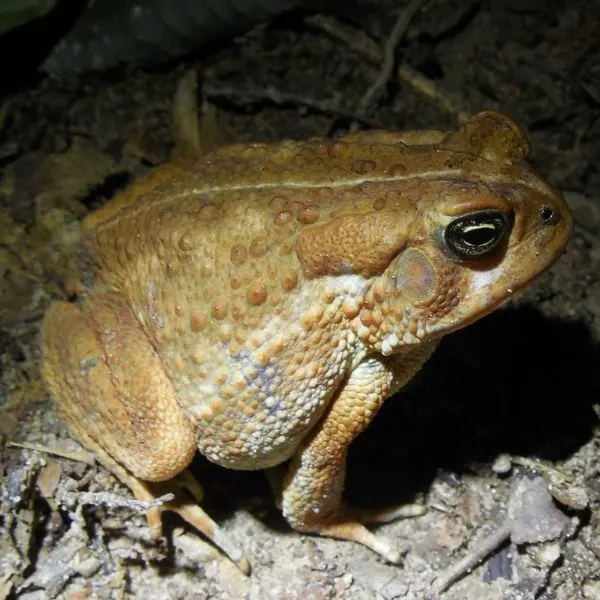
- Experience Level: Beginner
- Family: Bufonidae
- Scientific Name: Anaxyrus americanus
- Other Names: Eastern American Toad
- Adult Size: 2 to 3.5 inches
- Lifespan: 2 to 10 years
- Average Price Range: $20 to $30
American toads are medium-sized species and are found all over the southern United States. They are active in the spring and wet seasons of the ear. In dry periods and summer, they will burrow and hide under natural debris. Forests are the habitat they live in, and they will burrow when not active.
American toads only grow 3 inches at their largest and have brown or gray coloring. Yellow patches and a pale yellow stripe runs down the center of their back.
Their skin is dry, and they are covered in warts. This species can be identified by the spots that their warts lie on. A parotoid gland can be seen on their neck, which helps defend them from predators.
Animals like small dogs can be harem if this toxin is ingested. You should be careful if handling this species, as they can irritate the skin.
Some predators of this species will still eat this toad, as they have adapted to their skin toxin. This species usually eats insects, coming out at night to feed. Because they are nocturnal, you will not likely see them in the day but can find them under debris.
2. Fowler’s Toad

- Experience Level: Beginner
- Family: Bufonidae
- Scientific Name: Anaxyrus fowleri
- Other Names: Bufo fowleri
- Adult Size: 2 to 3 inches
- Lifespan: 2 to 5 years
- Average Price Range: $20
Fowler’s toads live in the eastern and southern United States and live in Alabama. Forests are their most common habitat, usually ones next to a permanent water source.
This species is nocturnal and is active from spring to fall, and breeding is triggered by heavy rainfall. Summer is when Fowler’s toads are seen most often, during moist nights.
Short legs, dry skin, and warts covering their body are traits of this species. They have brown or gray coloring, with a light dorsolateral stripe running down their back.
Light-colored blotches can be seen on their back, which also has a black surrounding. Their stomachs are pale, and males will have dark thoughts. This species is identified by having 3 warts within the dark spots on their back.
When mating males will make a sheep-like call that lasts for around 4 secs. Snakes, birds, and mammals are their most common predators. They used their camouflage to blend into the environment and try to avoid threats.
3. Oak Toad
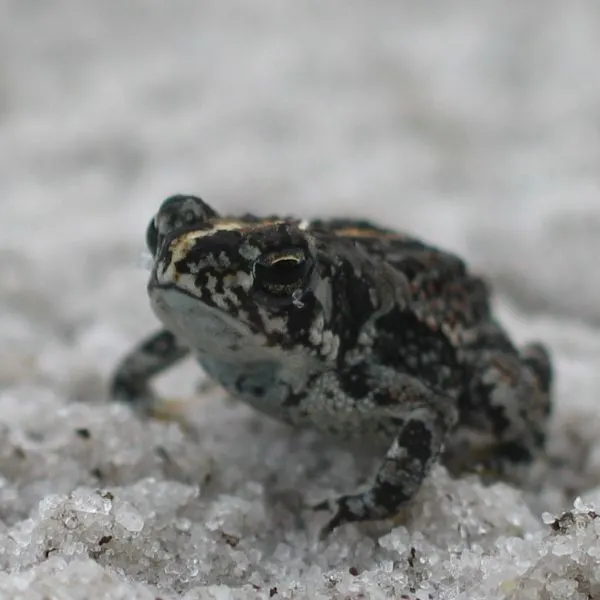
- Experience Level: Intermediate
- Family: Bufonidae
- Scientific Name: Anaxyrus quercicus
- Other Names: N/A
- Adult Size: 1.75 inches
- Lifespan: 1 to 2 years
- Average Price Range: $10
Oak toads are common in Alabama but often overshadowed by other frog species. They are a burrowing species and spend most of their life underground.
Pine Flatwoods, scrublands, and oak forests are habitats they live in, but they are mostly found in the coastal plain region. Oak Toads will only come out of their burrow to breed or feed on insects.
Dry skin and covered in warts are features they show, similar to other toad species. They have a parotoid gland around their neck that secretes a toxin used for defense.
The colors they exhibit include gray, brown, and sometimes black. Blotches can be seen along their back and legs, as well as a faint dorsal stripe.
The biggest threat to the oak toad is the loss of habitat, which is a reason for this species decline. Wetlands and other freshwater sources are vital for this species ability to breed.
Breeding season occurs from spring to early fall and is when this species is most active. They are a hard species to stuffy due to their secretive nature, but they will also emerge in heavy rainfall.
4. Southern Toad
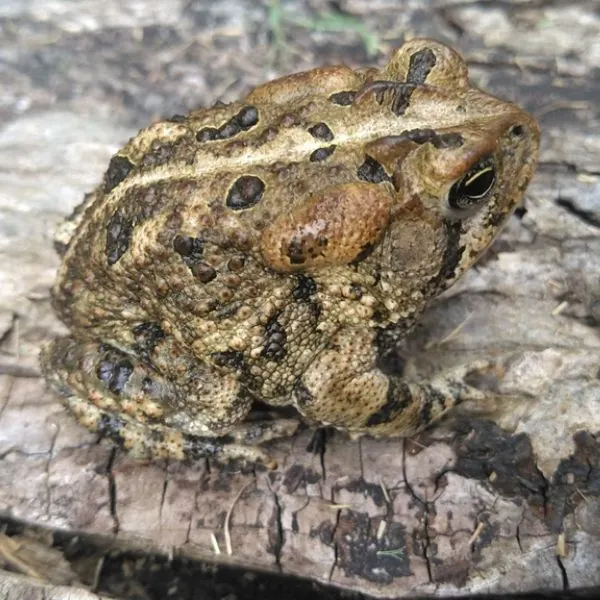
- Experience Level: Intermediate
- Family: Bufonidae
- Scientific Name: Anaxyrus Terrestris
- Other Names: N/A
- Adult Size: 2.5 to 3.5 inches
- Lifespan: 10 years
- Average Price Range: $10 to $20
Southern Toads can be found all over Alabama, except for the Northwestern half of the state. They live in areas with sandy soil to accommodate for their burrowing nature.
Coastal scrubs, woodland, residential areas, and fields are the common habitats they live in. A source of water is nearby wherever they live since during breeding season they use various aquatic sources to mate.
Southern toads are brown, gray, and black in color. Some toads will have a brick red coloring. Their bellies are grayish-white, and spots can be seen on their chest.
Southern toads have dry skin and are covered in warts of different sizes. A parotoid gland can be seen behind their eyes, and pointy knobs appear in front of the parotoid glands. Dark blotches cover their legs, and males will have a darker throat when compared with females.
Beetles, roaches, ants, cricket, and bees are just some of the prey the southern toad will hunt. They are protected by toxins that secrete from their parotoid gland and poisons predators. If in danger they will try to make themselves appear larger by inflating their lungs and stretching their legs.
5. Gopher Frog
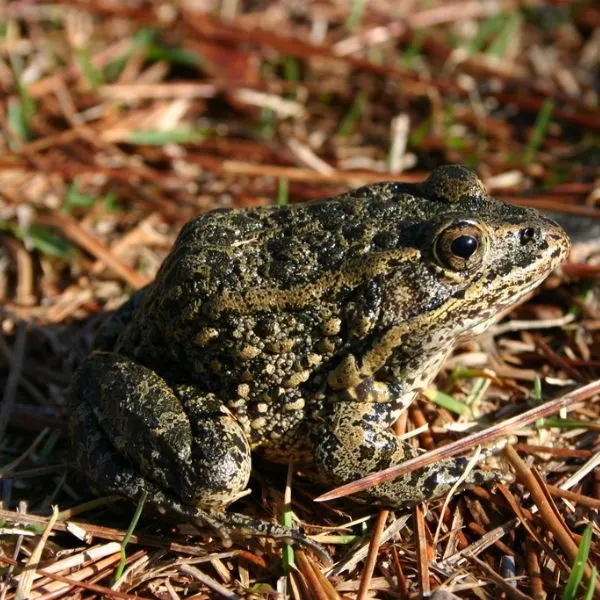
- Experience Level: Advanced
- Family: Ranidae
- Scientific Name: Lithobates capito
- Other Names: N/A
- Adult Size: 2.5 to 3 inches
- Lifespan: 2 to 5 years
- Average Price Range: N/A
Gopher frogs live in central Alabama and have a large range throughout the southeastern United States. They live in forests, pinewoods, prairies, and wetlands.
Adults spend their life underground and will come out to breed. Fall to spring is the duration of their breeding season.
Heavy rain will bring this species out, but they will also come out to feed. They are called gopher frogs because they use gopher holes as homes for themselves.
Gopher frogs are medium-sized species with tan, green, or gray skin. They have dark spots and a mottled pattern covering their body. A tan stripe sometimes runs down the sides of their body.
Gopher frogs will come out to feed on insects and small invertebrates. Beetles, ants, flies, and crickets are some of the food they eat.
Habitat loss and climate change are the main factors that threatened this species. They are not endangered but are experiencing a population loss, and are listed as “Near Threatened”.
6. Pig Frog
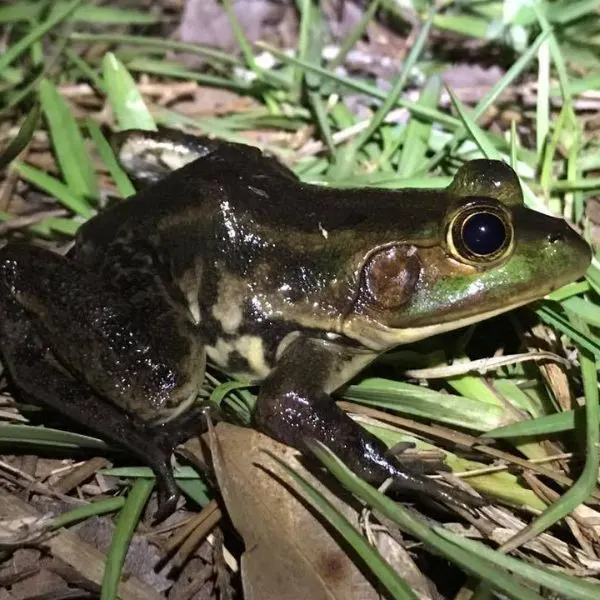
- Experience Level: Beginner
- Family: Ranidae
- Scientific Name: Lithobates grylio
- Other Names: Lagoon frog
- Adult Size: 3.24 to 5.5 inches
- Lifespan: 5 to 15 years
- Average Price Range: $20 to $40
Pig frogs have a range within Alabama and are mostly found within the coastal plains region of the state. They live in permanent bodies of water like lakes, ponds, swamps, and marshes.
This species is aquatic and prefers freshwater that is highly vegetated. Breeding starts in spring and ends in fall. As many as 10,000 eggs can be laid by a frog.
The pig frog is medium-sized but is able to grow larger than most frogs. They resemble bullfrogs but are generally smaller. Green or greenish-gray is their body color, with dark blotches covering their back.
Their belly is light and covered in spots. They have webbed feet and a large exposed eardrum on the side of their face. This species gets its name from the call that it makes when breeding, which sounds like a pig’s grunt.
Their size gives them an option of a variety of feed to prey on. Small amphibians, insects, snakes, crustaceans, and small mammals are some of the animals they prey on. In the night is when they are active and will hunt for their food.
7. American Bullfrog
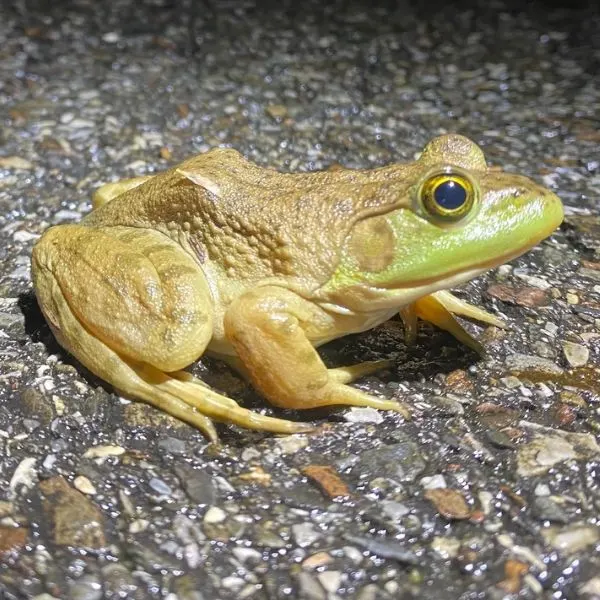
- Experience Level: Intermediate to Advanced
- Family: Ranidae
- Scientific Name: Lithobates catesbeianus (Rana catesbeiana)
- Other Names: Bullfrog
- Adult Size: 3.5 to 6 inches
- Lifespan: 7 to 15 years
- Average Price Range: $20
Bullfrogs are native to the eastern United States but have managed to spread their range all over the U.S. American bullfrogs live in Alabama, and every other state in the U.S now. They live near freshwaters like lakes, ponds, swamps, and bogs.
This species is common and prefers to live in habitats with highlighted vegetated waters. Bullfrogs are highly aquatic and are a dominant species wherever they live. This species has an invasive nature and will outcompete most frogs that live near it.
Bullfrogs are the largest species of frogs in North America and Alabama. They are green mixed with tan coloring. Dark blotches and a mottled pattern appear on their back. Their legs, feet, eyes, and body are all large in size.
A large tympanum can be seen on the side of their heads. Bullfrogs have a low call that sounds like a bull. They have light-colored bellies, and males have dark throats.
Since they are so large, bullfrogs will hunt a large number of species of different sizes. Birds, snakes, bats, insects, and fish are just some of the things they eat.
In areas where they are invasive, they will take resources from native species of frog. Some humans will also eat bullfrogs because they are so large.
8. River Frog
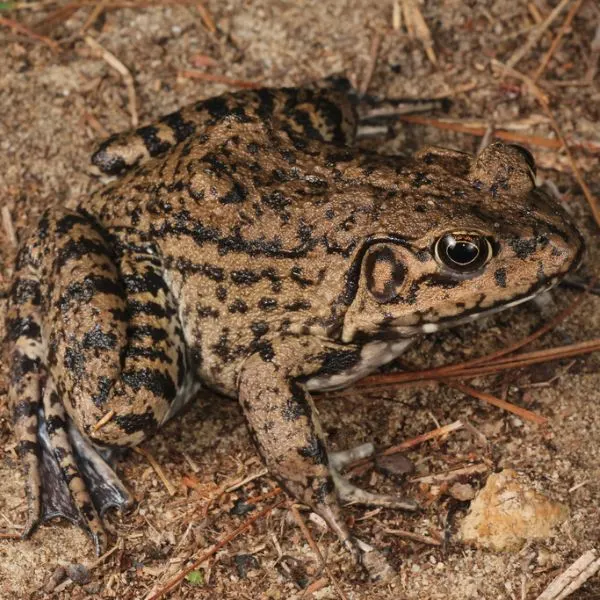
- Experience Level: Intermediate
- Family: Ranidae
- Scientific Name: Lithobates heckscheri
- Other Names: N/A
- Adult Size: 3 to 5 inches
- Lifespan: 5 years
- Average Price Range: N/A
River frogs have a small range in Alabama and are only found in the coastal plains region of the state. They live in blackwater habitats and are mostly aquatic. It is rare to see them during the day, and they are nocturnal.
This species of frog is large and even their tadpoles can reach up to 5 inches. Breeding occurs from April to August. Their call can be heard during this period, which is a low pitch roaring sound.
River frogs can be green, dark green, and close to black. They have dark bands on their legs and a mottled pattern on their back. Bullfrogs and pig frogs closely resemble this species. The river frog’s skin is rough and wrinkly. Their bellies are a pale yellow, and their eyes a bright red.
River frogs will play dead and put out an unpleasant odor to defend themselves. Predators of this species include bass, water snakes, and birds.
Some animals have been seen puking after eating a river frog, which means their skin may have a noxious substance on it. River frogs have a healthy population but are experiencing slight population loss due to habitat destruction.
9. Green Frog

- Experience Level: Beginner
- Family: Ranidae
- Scientific Name: Lithobates clamitans clamitans
- Other Names: Northern Green Frog, Bronze Frog
- Adult Size: 2.25 to 3.5 inches
- Lifespan: 15 to 20 years
- Average Price Range: $10
The bronze frog is a subspecies of the green frog that is found all over Alabama. Green frogs and bronze frogs inhabit the eastern United States.
The Bronze frog is only found in the extreme southeastern areas of the U.S. They can be found in freshwater habitats like pools, rivers, swamps, lakes, and streams. This species even inhabits swimming pools if given the opportunity.
Bronze frogs are named after their brownish bronze skin. They have smooth skin and a bright green mouth. Their belly is white with dark blotches covering it. On the side of their head is an exposed eardrum that is larger in males.
This species is active during the day, but also at night in warm temperatures. They are found near the edges of water and will escape into it when threatened. Flies, fish, snakes, and crayfish are some of the animals they prey on.
10. Pickerel Frog

- Experience Level: Intermediate
- Family: Ranidae
- Scientific Name: Lithobates palustris
- Other Names: Rana palustris
- Adult Size: 1.75 to 3 inches
- Lifespan: 5 to 8 years
- Average Price Range: $10 to $15
Pickerel frogs have a scattered population in Alabama. They live in the piedmont and mountain regions. Ponds, lakes, and slow-moving freshwater is preferred in their habitat. They are semi-aquatic species that can be found on land or water.
Pickerel frogs have a similar look to leopard frogs. They have green to brownish skin with dark spots covering their back. In between their hind legs are bright yellow coloring. Dorsolateral folds appear on the sides of their back, and their belly is covered in spots.
The toxin can be secreted from this frog’s skin that is harmful to small animals. Snakes and other amphibians will usually not eat this species to avoid death.
Humans should also be careful when handling this species as their toxin can irritate the eyes and skin. This species is carnivorous and survives by eating small invertebrates.
11. Mississippi Gopher Frog
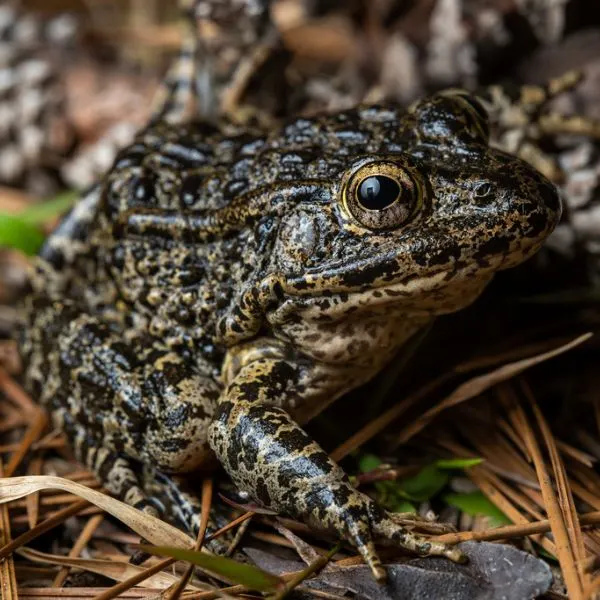
- Experience Level: Advanced
- Family: Ranidae
- Scientific Name: Lithobates sevosus
- Other Names: Dusky Gopher Frog, Tammany Gopher Frog
- Adult Size: 3 inches
- Lifespan: 6 to 10 years
- Average Price Range: N/A
Mississippi gopher frogs are an endangered and rare species in Alabama. They live in areas with sandy soil and use the holes of the gopher tortoise as a home.
Temporary water sources are used for breeding. When not breeding they will stay underground in tortoise holes. Heavy rain is what will trigger breeding.
The Mississippi gopher frog is light gray or brown and covered in dark blotches. Their belly is a pale yellow, covered in small dark spots. Bumps and warts cover their bodies. Their eyes are large and protrude from their head.
Gopher frogs are endangered and require a specific habitat to survive. The loss of habitat as well as predation from other species is why they are considered critically endangered.
Species like snakes, fish, and birds will prey on these species. They also face threats from disease.
12. Southern Leopard Frog
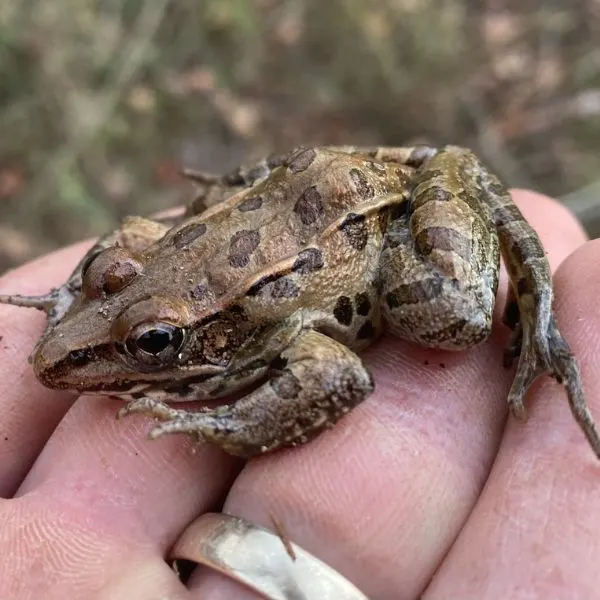
- Experience Level: Beginner
- Family: Ranidae
- Scientific Name: Lithobates sphenocephalus
- Other Names: Rana sphenocephalus
- Adult Size: 2 to 3.5 inches
- Lifespan: 2 to 4 years
- Average Price Range: $10 to $15
The southern leopard frog is one of the most common species in Alabama, along with the bronze frog. They live in a variety of freshwater habitats and will use fishless waters to breed. When not breeding they will travel on land and are sometimes seen far from water. In the day or night, they will be active and will hibernate underground for winter.
Southern leopard frogs are named after the leopard-like pattern that is painted on their bodies. These dark spots can be seen on their backs and legs. Their base color is green to tan, and they have a light stripe running across their jaw.
Ants, beetles, worms, and whatever they can fit into their mouth is what this species will eat. Southern leopard frogs are considered opportunistic feeders. Predators of this species include fish, raccoons, skunks, and snakes.
13. Wood Frog

- Experience Level: Beginner
- Family: Ranidae
- Scientific Name: Lithobates sylvaticus
- Other Names: Rana sylvaticus
- Adult Size: 1.375 to 2.75 inches
- Lifespan: 1 to 3 years
- Average Price Range: $15 to $30
Wood frogs are rare to find in Alabama, but they can sometimes be found in forests. Moist habitats with high ground litter are their preferred habitats.
During the breeding season, they will travel to fishless fresh waters to mate. When not breeding they are often found far away from water sources.
In winter this frog will hibernate on the ground under leaves, logs, and other debris. They are one of the most cold-resistant species and can survive freezing.
Wood frogs are brown and medium-sized. They have a dark mask pattern running from along with their eyes and snout. They also have a light stripe below their lip. Dark blotches can sometimes appear on their legs, as well as a mottled pattern on their back.
Wood frogs eat insects and small invertebrates. They catch their prey by swinging their tongue forward and catching them with the tip of it. This species is not endangered but rare in Alabama.
14. Crawfish Frog
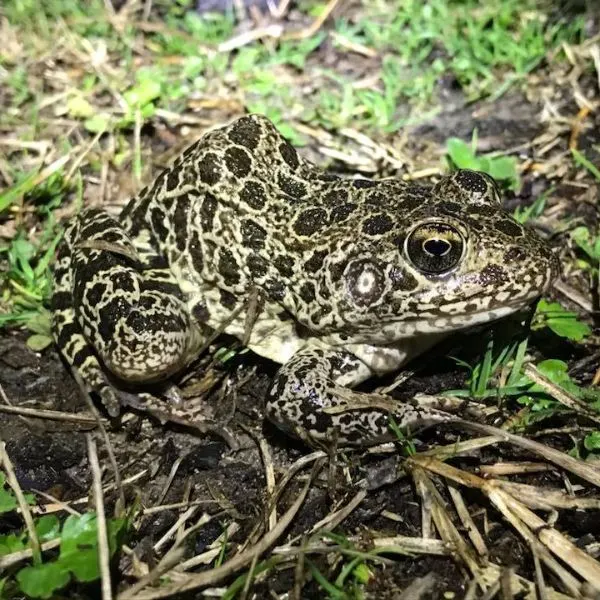
- Experience Level: Intermediate
- Family: Ranidae
- Scientific Name: Lithobates areolatus
- Other Names: N/A
- Adult Size: 2.5 to 3 inches
- Lifespan: 7 years
- Average Price Range: N/A
Crawfish frogs live in grasslands and prairies. They get their name from their habit to take shelter in crayfish burrows. They spend most of their time underground.
In spring breeding occurs on rainy days. In Sumter County Alabama, they have a large population. Wetlands, ponds, and fishless waters in the breeding season are when they are seen most often.
This species is medium-sized and ranges from brown to yellow in color. They have dark blotches on their back and legs. Skin folds can be seen on their sides, as well as an exposed eardrum.
Since they will never be found far from their burrow they use it as a means to escape predators. They will feed on insects and small invertebrates that may run by their burrow.
The crawfish frog is a species that is losing its population and is considered near threatened as a species. In some areas they live in they have been completely extirpated.
15. Greenhouse Frog
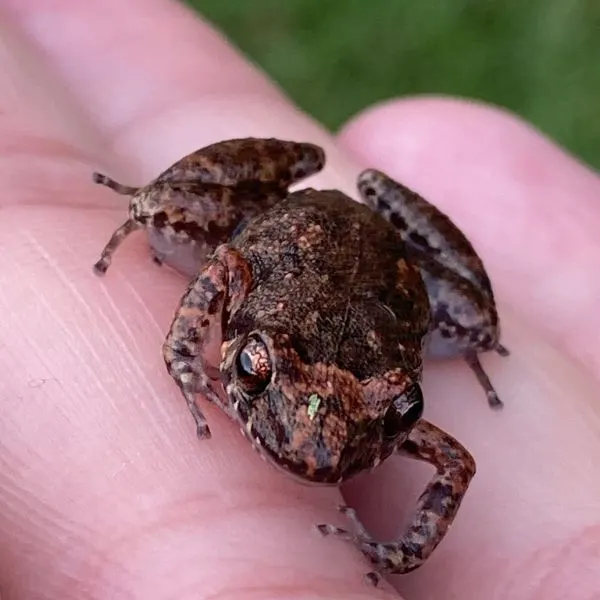
- Experience Level: Beginner
- Family: eleutherodactylidae
- Scientific Name: Eleutherodactylus planirostris
- Other Names: N/A
- Adult Size: 0.75 to 1.5 inches
- Lifespan: N/A
- Average Price Range: N/A
Greenhouse frog is a species native to Cuba that has become an invasive species in many areas. In Alabama, they are an invasive species and live in areas with a high amount of leaf litter. They are nocturnal and were brought to the U.S by foreign shipments of potted plants.
This species is small and rarely gets larger than an inch. Olive, brown, and tan are common colors they appear in. Stripes run down their back as well as a mottled pattern. Their belly is pale and they have noticeably bright red eyes.
Insects like spiders, beetles, roaches, and mites are what they eat. Greenhouse frogs will lay their eggs in natural debris and flower pots. They will stay near their eggs to protect them from predators.
They are highly invasive but are eaten by larger frogs, birds, and snakes which help control their population.
16. Eastern Spadefoot Toad
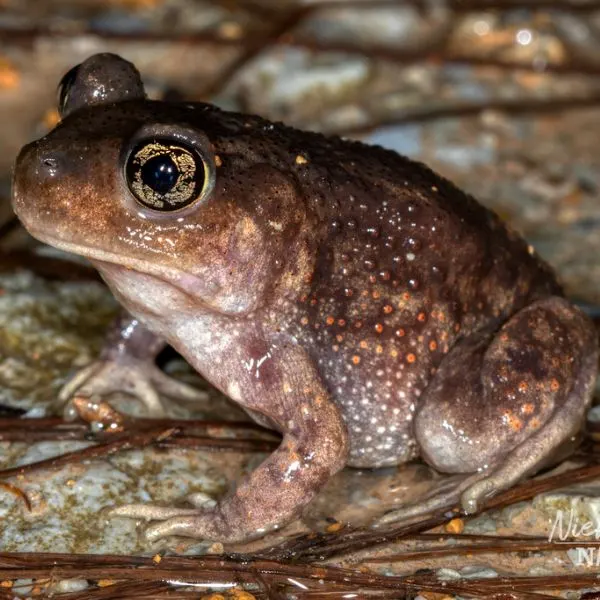
- Experience Level: Beginner
- Family: Pelobatidae
- Scientific Name: Scaphiopus holbrookii
- Other Names: The spadefoot toad
- Adult Size: 1.75 to 2.25 inches
- Lifespan: 2 to 10 years
- Average Price Range: $10 to $20
Eastern spadefoot toads live all over Alabama and inhabit the southeastern United States. They live in dry habitats with sandy soil used for burrowing. When not breeding, they will stay buried for an extended period. Breeding is triggered by rain, and they lay eggs in fishless waters.
The eastern spadefoot toad has smooth skin and minimal warts. They have yellow to brown coloration and have vertical lines running down their back. Males have brighter colors than females. Their eyes are bright yellow with cat-like pupils.
This species is able to secrete a toxin from its skin that can irritate humans. They have a peanut butter smell when handled. Insects and other small invertebrates are what they eat.
17. Eastern Narrow-mouthed Toad
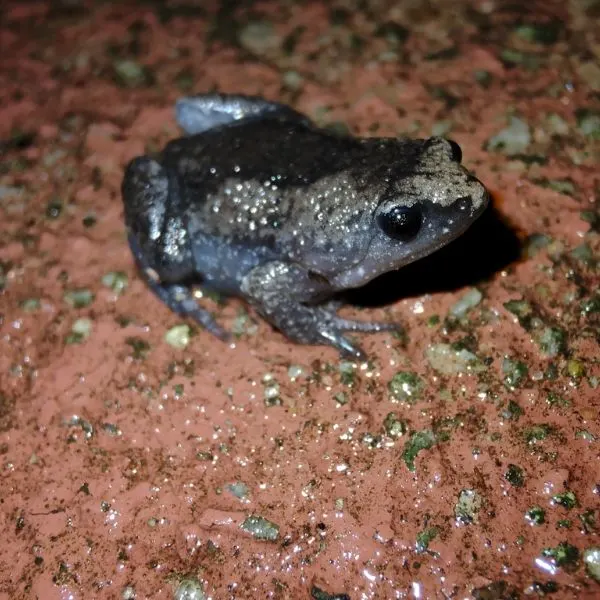
- Experience Level: Intermediate to Advanced
- Family: Microhylidae
- Scientific Name: Gastrophryne carolinensis
- Other Names: Narrowmouth toad
- Adult Size: 1.5 to 2 inches
- Lifespan: 6 years
- Average Price Range: $10
Eastern narrow-mouthed toads live in habitats with sandy soil used for burrowing. They spend a majority of their life hiding and will come out to breed and feed.
They are also found under logs and other natural debris. Breeding takes place from spring to fall and happens in freshwater habitats.
Narrow-mouthed toads have round flat bodies, and pointed heads. They vary in color from brown, gray to reddish-brown. They can sometimes change their color to better blend into their environment. A mottled pattern can be seen on their back, and their bellies are a pale color.
Ants make up a majority of their diet, but they will also eat other small insects. When threatened they will usually run instead of leap. Their call sounds like a long “waaaaa” noise.
18. Pines Barrens Treefrog
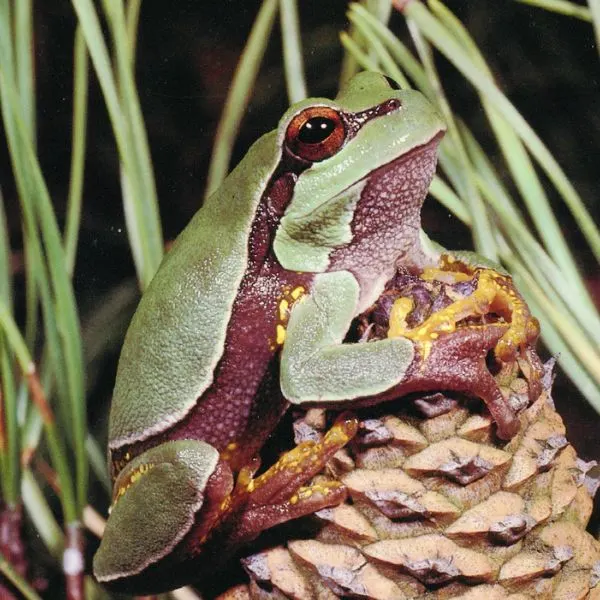
- Experience Level: Advanced
- Family: Hylidae
- Scientific Name: Dryophytes andersonii
- Other Names: N/A
- Adult Size: 1 to 1.25 inches
- Lifespan: 2 to 5 years
- Average Price Range: N/A
The pine barren treefrog can be found in the eastern United States and parts of Alabama.
They live in freshwater habitats with dense vegetation. Bogs, marshes, and pine forests are some of the habitats they live in. They are able to lay eggs and tolerate water with a higher pH than other frogs.
This frog is green with a dark stripe running down its side. Orange spots also cover the inside of their inner legs. This species looks similar to the American green tree frog but has dark stripes on the side of this body.
Small insects and invertebrates like ants, flies, and beetles are what they eat. This species population is declining mostly due to a loss of its habitat.
19. Northern Cricket Frog
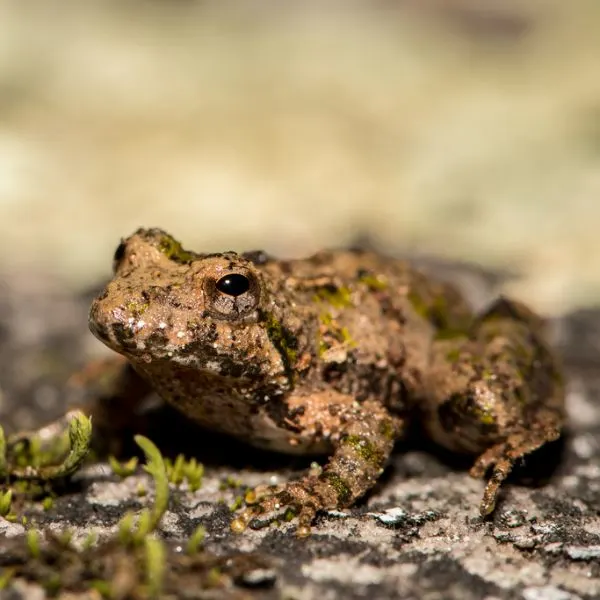
- Experience Level: Beginner
- Family: Hylidae
- Scientific Name: Acris crepitans
- Other Names: N/A
- Adult Size: 0.74 to 1.5 inches
- Lifespan: 5 to 10 years
- Average Price Range: $10 to $20
Northern cricket frogs live near lakes, ponds, rivers, and other slow-moving water sources. They prefer vegetated waters and spend most of their time on ground level.
They are a common species, and easily confused with the southern cricket frog. The call of these two species can help distinguish the two. The northern cricket frog’s mating call is faster than the southern cricket frog.
These frogs are small and covered in warts. They have brown, green, and gray coloring. A dark bar pattern covers their body, and a triangular mark sits on the top of their head. On the center of their back runs a bold stripe that varies from brown to green in color.
Since they are not good climbers they spend a majority of their time near the banks of the water. Insects are their main source of food, and they usually hunt at night.
20. Southern Cricket Frog

- Experience Level: Beginner
- Family: Hylidae
- Scientific Name: Acris gryllus
- Other Names: southeastern cricket frog
- Adult Size: 0.75 to 1.5 inches
- Lifespan: 5 to 10 years
- Average Price Range: $5 to $10
Southern cricket frogs can be found all over Alabama and other southeastern states. Moist habitats with vegetation are their preferred habitat. They are not great climbers and spend most of their time on the ground. They are common to see near rivers, ponds, and other freshwaters.
This species is small with brown, gray, or green skin. They have a bold stripe that runs along its back that is orange, green, or brown. Their bodies are covered in small warts like a toad.
Cricket frogs use their strong jump to help them avoid predators like snakes, turtles, and other frogs. They are insectivores and feed mostly on mosquitoes.
This species has a stable population and benefits humans by controlling the pest insect populations.
21. Cope’s Gray Treefrog
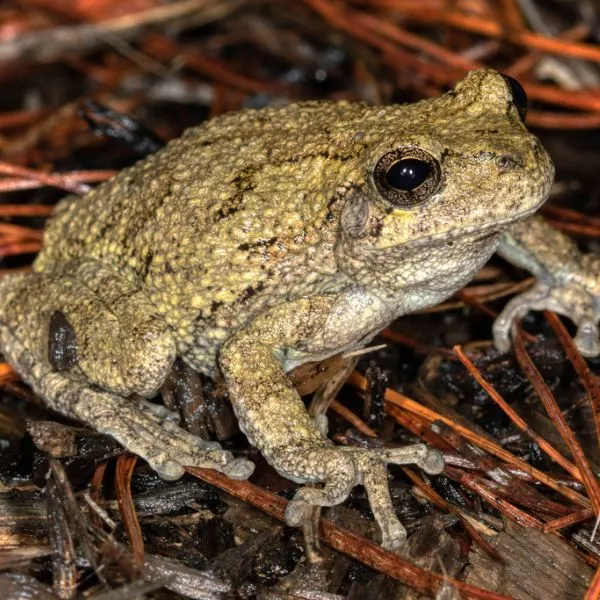
- Experience Level: Beginner to Intermediate
- Family: Hylidae
- Scientific Name: Dryophytes chrysoscelis
- Other Names: Southern Gray Treefrog
- Adult Size: 1.25 to 2 inches
- Lifespan: 10 to 15 years
- Average Price Range: $20
The cope’s gray tree frog is the only gray tree frog species found in Alabama. They live all over the state, inhabiting forests and wooded habitats.
This species will breed in freshwaters, but mostly fishless wetlands. They are active from spring to late fall. Summer is when they are the most active and can be seen breeding.
This species is a larger tree frog with bumpy skin. Their bodies range from green to gray and have a mottled pattern covering them. In between their legs is orange coloring with dark spots. The shade of their coloring also changes depending on the environment and temperature.
Insects are this species main source of food, similar to other smaller frogs. To protect themselves they will secrete an irritating toxin. You should be wary when handling this species to avoid skin irritation. They also rely on their camouflage to help stay hidden.
22. Bird-voiced Treefrog
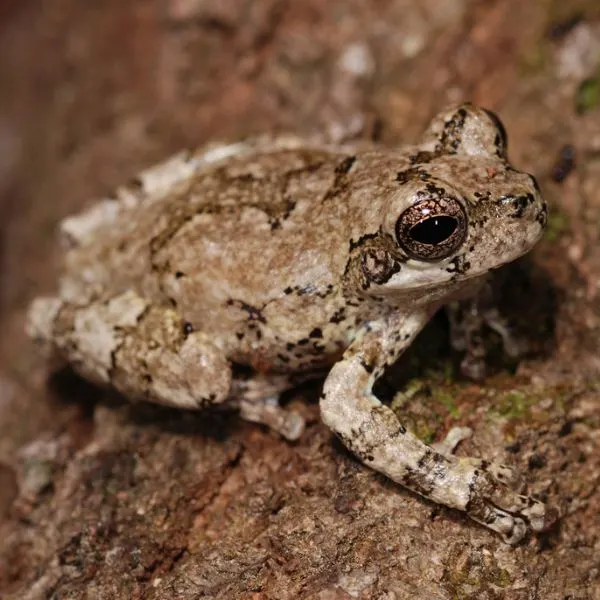
- Experience Level: Intermediate to Advanced
- Family: Hylidae
- Scientific Name: Hyla avivoca
- Other Names: N/A
- Adult Size: 2 inches
- Lifespan: 2.5 to 4 years
- Average Price Range: N/A
Bird-voiced tree frogs can be found in the southern half of Alabama.
They live in woodlands, swamps, and densely vegetated habitats near water. This species is nocturnal and will spend the majority of its time in trees. They will breed in spring and summer, calling near the edges of the water. They are named after their repetitive call which sounds similar to a bird.
This species is green, gray, or brown. They are able to change their shade to help blend into their environment like other tree frogs. Its belly and limbs are gray with a mottled pattern. Near their hind legs is yellow coloring that they will flash to confuse predators.
Insects and small invertebrates make up a majority of their diet. They hunt at night when active. Heavy rainfall will also make this species become more active. In the areas they live in this species has a large population, with no visible decline in population.
23. Green Tree Frog
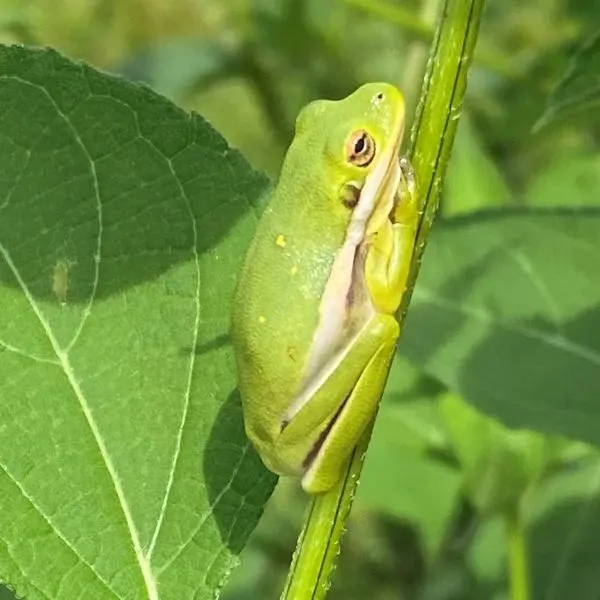
- Experience Level: Intermediate
- Family: Hylidae
- Scientific Name: Dryophytes cinereus
- Other Names: American green tree frog
- Adult Size: 2 to 2.5 inches
- Lifespan: 2 to 6 years
- Average Price Range: $10
Green tree frogs have a state-wide range in Alabama and can also be found in other southeastern states.
They live in swamps, lakes, and near the edges of freshwater. In the daytime, they will prefer to be in dark shady areas. Breeding starts in spring and goes to early fall. They prefer to breed in permanent water sources.
Green tree frogs are large and slender. They have green to yellowish coloring with a white stripe on the side of their lip. Spots may appear on the back that is yellowish. Their bellies are pale, and their skin is smooth.
The green tree frog is an abundant species. They will feed on insects like crickets and will choose prey that is more active. In the trees and on branches is where they are commonly found since they enjoy climbing. In their habitats, they prefer there to be a large amount of vegetation.
24. Pine Woods Treefrog
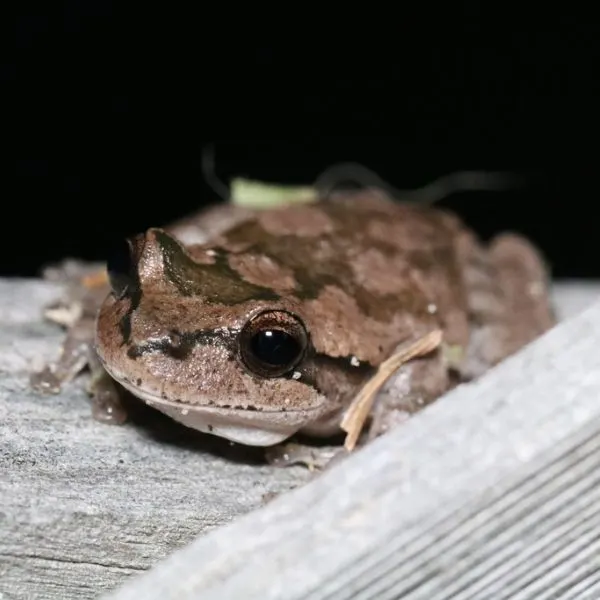
- Experience Level: Intermediate
- Family: Hylidae
- Scientific Name: Dryophytes femoralis
- Other Names: Morse Code Frog
- Adult Size: 0.75 to 1.5 inches
- Lifespan: 2 to 4 years
- Average Price Range: $20
In Alabama pinewoods, tree frogs inhabit forests, swamps, and flatwoods in the coastal plains region. They spend most of their time in trees and are sometimes spotted walking on the ground.
This species is most active on warm winter days and will hide under rocks, logs, and other natural debris when temperatures drop.
Brown, reddish-brown, gray, and green are the colors this species portrays. They have smooth skin and light dark colored blotches covering them.
This species looks similar to the barking tree frogs. To differentiate them from other tree frog species they have yellow, orange, and black coloring between their legs.
Flies, beetles, crickets, ants, and moths are some of the animals the pinewoods tree frogs eat. Birds, mammals, and reptiles will prey on this species, but in Alabama their predator list is unknown.
The pinewoods barren tree frog has a stable population and is listed as a species of “Least Concern”.
25. Barking Treefrog
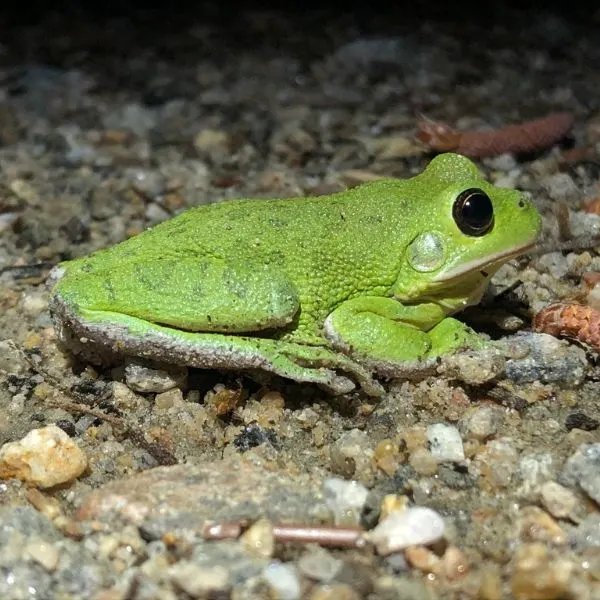
- Experience Level: Beginner
- Family: Hylidae
- Scientific Name: Dryophytes gratiosus
- Other Names: N/A
- Adult Size: 2 to 2.75 inches
- Lifespan: 5 to 10 years
- Average Price Range: $15
Barking Tree Frogs inhabit most of Alabama. They live in wooded habitats and use freshwater sources to breed.
Marshes, wetlands, and other shallow vegetated waters are what they use to breed. Mals will float on the top of water and call during the breeding season. Their mating call songs like a loud “Donk” noise.
Barking tree frogs are one of the largest species of tree frogs where they live. They have bump skin and bright green coloration. A white line appears near their lip, and dark blotches cover their back. Their bellies are white, and their feet have toe pads to help them climb.
Crickets, earthworms, and wax worms are some of the animals this species eats. They are a gentle species that are sometimes kept as pets.
When kept in a terrarium with a suitable habitat, and fed properly they can live up to 10 years.
26. Squirrel Treefrog

- Experience Level: Intermediate
- Family: Hylidae
- Scientific Name: Hyla squirella
- Other Names: Rain frogs
- Adult Size: 1 to 1.5 inches
- Lifespan: 5 to 9 years
- Average Price Range: $10
Squirrel treefrogs are a species found in Alabama, mostly in the coastal plains regions. They live in a variety of habitats like woodlands, riparian zones, and even residential areas. Breeding for this species starts in spring and ends in early fall. They have a “quack” like call and will lay eggs in vegetated waters.
Squirrel tree frogs are small and usually stay under two inches. They have green, gray, or brown skin with a white line running across their upper lip. Their skin is moist and smooth-looking.
Squirrel tree frogs have large eyes and toe pads that help them climb. They look similar and are often confused for other tree frog species like the Green frog, Barking treefrog, and Pinewoods treefrog.
These frogs are often called rain frogs since they are more active and can be heard in the rain. Nocturnal most of the time, they can sometimes be spotted hunting for food in the day. Insects are what they feed on, and will go to areas with a light source that attracts insects.
27. Spring Peeper

- Experience Level: Intermediate
- Family: Hylidae
- Scientific Name: Pseudacris crucifer
- Other Names: N/A
- Adult Size: 0.75 to 1.25 inches
- Lifespan: 2 to 4 years
- Average Price Range: $10 to $20
Spring peepers are found across Alabama in suitable habitats across the state. Forests, woodlands, and other wooded areas are where they live.
Permanent water sources are present in all their habitats which they use to breed. When not breeding they will spend most of their time on land. Spring peepers call from the water when trying to breed.
They are one of the first species to emerge in spring and usually signal the start of the season.
Brown, light tan, and olive green are their color variants. Dark blotches and bars over their legs and body. A dark X mark appears on the top of their head. White is their belly color, and males will have a dark throat.
Spring peepers are nocturnal and spend the night hunting for food. They eat insects like ants and beetles. Predators of this species include snakes, birds, and larger frogs.
Spring peepers have a healthy population and are considered a species of “least concern”.
28. Upland Chorus Frog

- Experience Level: Intermediate
- Family: Hylidae
- Scientific Name: Pseudacris feriarum
- Other Names: N/A
- Adult Size: 0.75 to 1.75 inches
- Lifespan: 1 to 5 years
- Average Price Range: N/A
The upland chorus frog inhabits areas within the eastern United States and has populations in Alabama. Rivers, marshes, ponds, and swamps are near areas where they live, as they use these to breed.
Woodland, forests, and densely vegetated areas are the upland chorus frogs’ habitats. Late winter to spring is when they breed. In the coldest parts of winter partially freeze and remain inactive.
Brown, reddish-brown, and gray are the colors of this species. They have a dark line that runs down the side of their body, and dark spots covering them. Similar to other chorus frogs they have a white line around their lip. Their skin is wet-looking and covered in small bumps.
This species will only eat small insects and invertebrates. Snakes, larger frogs, and birds will prey and feed on this species. They will use their camouflage and small size to avoid predators.
29. Mountain Chorus Frog

- Experience Level: Intermediate
- Family: Hylidae
- Scientific Name: Pseudacris brachyphona
- Other Names: N/A
- Adult Size: 1 to 1.25 inches
- Lifespan: 1 to 3 years
- Average Price Range: N/A
Mountain chorus frogs have a range in the eastern United States. In Alabama, they can only be found in the northern half of the state.
In high elevations of around 3500 feet, they inhabit woodland, forests, and hillsides. They will use shallow bodies of water to breed from March to May. In summer they are not seen often and will hide in leaf litter and under debris.
Small in size their colors range from gray to olive green. A dark mark can be seen on their back that resembles parentheses. They also have a triangular mark on their head, and a white line on their upper lip similar to other chorus frogs. The side of their legs is yellow, which they use to confuse predators. Dark mottled patterns on their back and legs are present in this species.
Mountain chorus frogs are secretive species, so studying them has been difficult. They are thought to be declining within their range similar to other amphibian species. Like other chorus frog species they survive on small insects and invertebrates.
30. Ornate Chorus Frog

- Experience Level: Intermediate
- Family: Hylidae
- Scientific Name: Pseudacris ornata
- Other Names: N/A
- Adult Size: 1 to 1.5 inches
- Lifespan: 1 to 3 years
- Average Price Range: N/A
Ornate chorus frogs can be found in Alabama, but only have a range in the southwest region of the state. This species is found in the coastal plains. They live in wetlands, forests, meadows, and other moist habitats. When not breeding they spend a majority of their time in burrows.
Ornate chorus frogs are a small species with brown, green, and gray coloring. A dark stripe runs down the side of their face, running through their eye. Dark patterns can be seen on their legs, and a triangular mark appears on the top of their head.
Winter is when this species is most active, and they will begin to breed. Breeding lasts until March, and they will then return back into their burrows.
Ornate chorus frogs will also come out of their burrows to feed at night. They eat small insects and invertebrates.
Fires are needed for this species’ habitat to maintain itself. Habitat changes and loss are the main reasons for this frog’s decline.
31. Southern Chorus Frog

- Experience Level: Intermediate
- Family: Hylidae
- Scientific Name: Pseudacris nigrita
- Other Names: N/A
- Adult Size: 0.75 to 1.25 inches
- Lifespan: 1 to 3 years
- Average Price Range: N/A
Southern Chorus frogs live in the coastal plains region, in wet and moist habitats. Most of their time is spent in burrows or under debris. Grasslands, pinewoods, and highly vegetated areas are preferred by this species. Southern chorus frogs are most active in winter and will breed until April.
This frog is small and slender. They have dark stripes running down their back that turn into spots. Their skin is moist but has small granular bumps on them. Brown to green is the color they are found in. Dark patterns cover their legs, back, and sides.
Small insects like ants, flies, and beetles are what they feed on. This species remains out of sight and is only active during the breeding season. This secretive nature makes them rare to find in nature and hard to study. Southern Chorus frogs are fed on by water snakes, birds, and other large species of frog.
32. Little Grass Frog

- Experience Level: Intermediate to Advanced
- Family: Hylidae
- Scientific Name: Pseudacris ocularis
- Other Names: N/A
- Adult Size: 0.75 inches
- Lifespan: 5 to 10 years
- Average Price Range: N/A
Little grass frogs have a population within southeastern Alabama. They live in wetland habitats and moist areas. Little grass frogs prefer moist meadows and boggy areas, with a dense population in the coastal plains region. They are active from winter to fall and can be heard calling year-round.
Little grass frogs are the smallest species of native frogs in North America. They have slender bodies and pointed heads. Green, brown, red, and pink are their common coloring. Dark stripes run down their body, as well as other patterns. This frog can easily fit on your fingertip, and its small size makes them easily identifiable.
Little grass frogs are tiny so are preyed on by predators like birds, fish, and other frogs. They use their long legs to jump and escape predators. This small species is capable of jumping at least 2 feet. They feed on small insects they come across in the soil.
Wrapping up
Alabama has 32 species and subspecies living in the state. New species are continuously being discovered. Frogs from other areas can also become invasive if the conditions are right.
Helping to create a balanced ecosystem, frogs control insect populations and are food for larger predatory animals like birds or foxes. Frogs bring balance, and a healthy population of the endemic species is a sign of a healthy environment.
Today amphibians face many challenges, with more losing their population at a faster rate. Disease, pollution, and a loss of suitable habitats are what many species are facing.
Learning about and protecting the local frog species can help save endangered ones, as well and stop others from the population decline. Frogs are beneficial to the environment, and some can even make a good pet if you are looking for an amphibious companion.
This list of all 32 frog species in Alabama should be helpful for the next time you are looking to learn about a species, or identify ones near you.
Their physical features, location, and mating call can tell the species apart. Some frogs have minor differences and are almost impossible to differentiate with only a glance.
Nearby states
